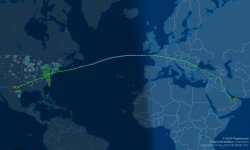For any of our pilots who fly into HBA.
Last year, Air Services Australia changed from individual flight vectoring for approach (and, I guess, departures) to a standard approach path. Its been a bit controversial locally as ASA got caught out not doing the 'community consultation' it was supposed to do - they just announced it as a fait accompi.
Now its 'under review'.
As all commercial flights arrive from the north, if they have to land towards the north, previously most would come down the Coal River Valley a bit to the north-east of a southerly landing approach, then do a sporty, tight right hand turn over Tiger Head Bay and then land. This was always a bit of a thrill when the winds were up.
Now, the standard southern approach takes the aircraft more to the east, over populated areas (mainly small towns - such as Carlton River, Dunally, I think), then much further to the south (down to Slopen Island, I think) before turning and approach.
Question for pilots, if they do this run - was there any pressure or wish from them to have this change? I understand that it was mainly driven from ?Melbourne? control, as they previously had to deal with each individual craft, but now its more 'set and forget' (not really, I know, but hopefully that's the gist).
View attachment 123080















